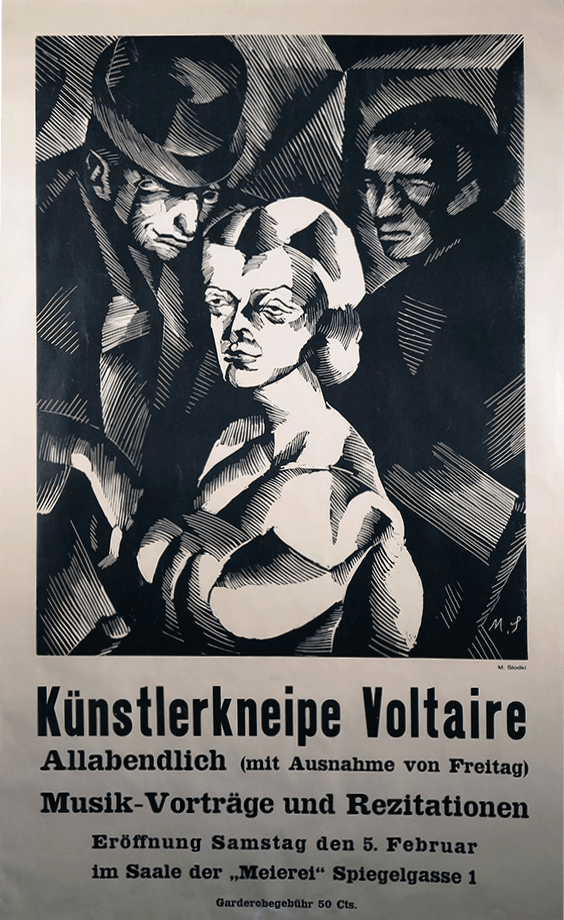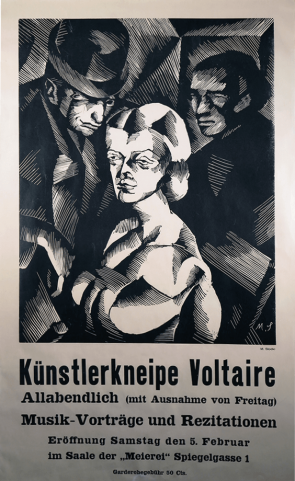This poster advertised the opening of the Künstlerkneipe Voltaire (artists’ bar Voltaire) in hotels, cafés, and bookstores. Marcel Słodki’s woodcut shows a motif from the shady demimonde of Zurich’s old center, where the Dadaists found their small sized theater. The poster evokes Tristan Tzara’s brief description of Spiegelgasse (“the darkest street in the shadows of sloping buildings where you come upon discreet detectives between the red lanterns”) and conveys the rough breath of such poems as recited by Emmy Hennings in the Cabaret. As wood has many grains, figures live in many veins. The poster was also shown in the exhibition in the Cabaret Voltaire together with two portraits by Słodki, one of Dostoyevsky and another of Tolstoy. A woodcut by the artist illustrating the publication Cabaret Voltaire shows a similar motif; a weak light casts eerie, dramatically contoured shadows. Another master of the Expressionist woodcut in the emergence of Dada Zurich was Christian Schad.
Until spring 1916, the Dadaists ran their place in the function room of the Dutch Wine Bar Meierei as a “Künstlerkneipe,” an artists’ bar; by renaming it to Cabaret Voltaire the internationally oriented Dadaists aimed at counteracting the accusation of jingoistic hyper-Germanness. The high frequency of performances—staged almost every evening—was elating, yet proved to be exhausting in the long run. Hugo Ball, artistic director of the cabaret, noted in his diary after only a few weeks: “The cabaret needs some rest. The tension given, the daily appearance does not only exhaust us, but wears us down. The bustle has me trembling all over. I simply cease to be able to take in anything, drop everything, and run away.” The cabaret was closed after barely five months. The Zurich Dadaists’ second permanent domicile was the Galerie Dada in the “Sprüngli House” on Paradeplatz from 1917 on.
Marcel Słodki had come to Zurich in 1915 after his studies at the Academy in Munich and a sojourn in Rome. He stayed intermittently until 1920, presenting his works in the 1st Dada Exhibition and in the Exhibition of Graphic Works, Embroideries, and Reliefs in the Galerie Dada. He was one of the first artists who moved into a studio in the Zurich studio house on Rousseaustrasse in 1918.
Number of copies unknown. The poster was purchased from the bookstore and art dealer Hans Hack, Oetenbachgasse, Zurich. Provenance: Kunstgewerbemuseum Zürich, 1992. First exhibition: Zürich, Cabaret Voltaire, Ausstellung Cabaret Voltaire, 1916.
→ Karl Schlegel, invitation card for the opening of the Künstler-Kneipe Voltaire, DADA V:49
→ Cabaret Voltaire, DADA III:37
→ Emmy Hennings, Gedichte [Poems], DADA II:1
→ Emmy Hennings, letter to Reinhold Rudolf Junghanns, DADA II:27
→ Christian Schad, Onéirodynie en Kova, Gr.Inv. 1985/105

